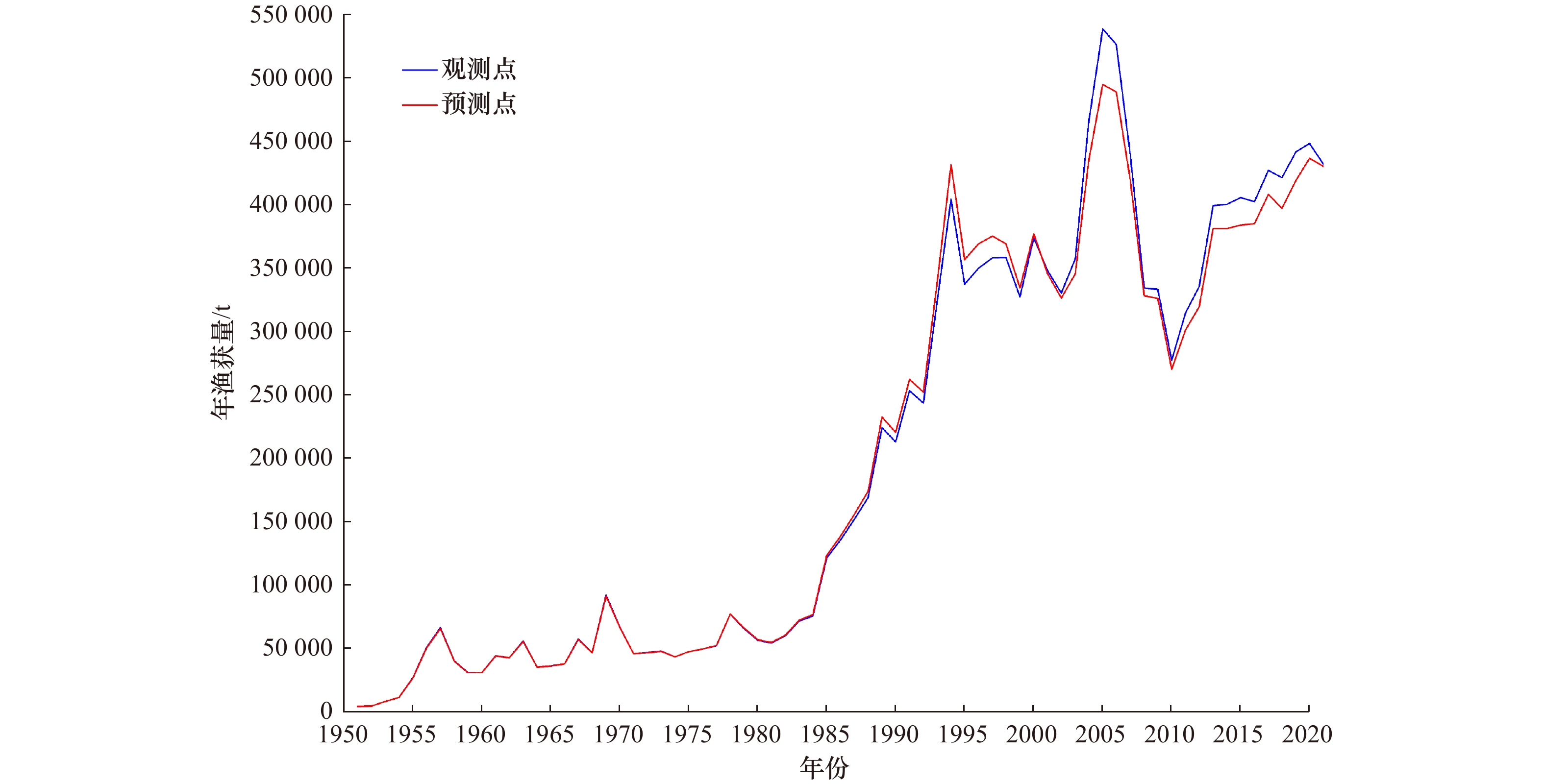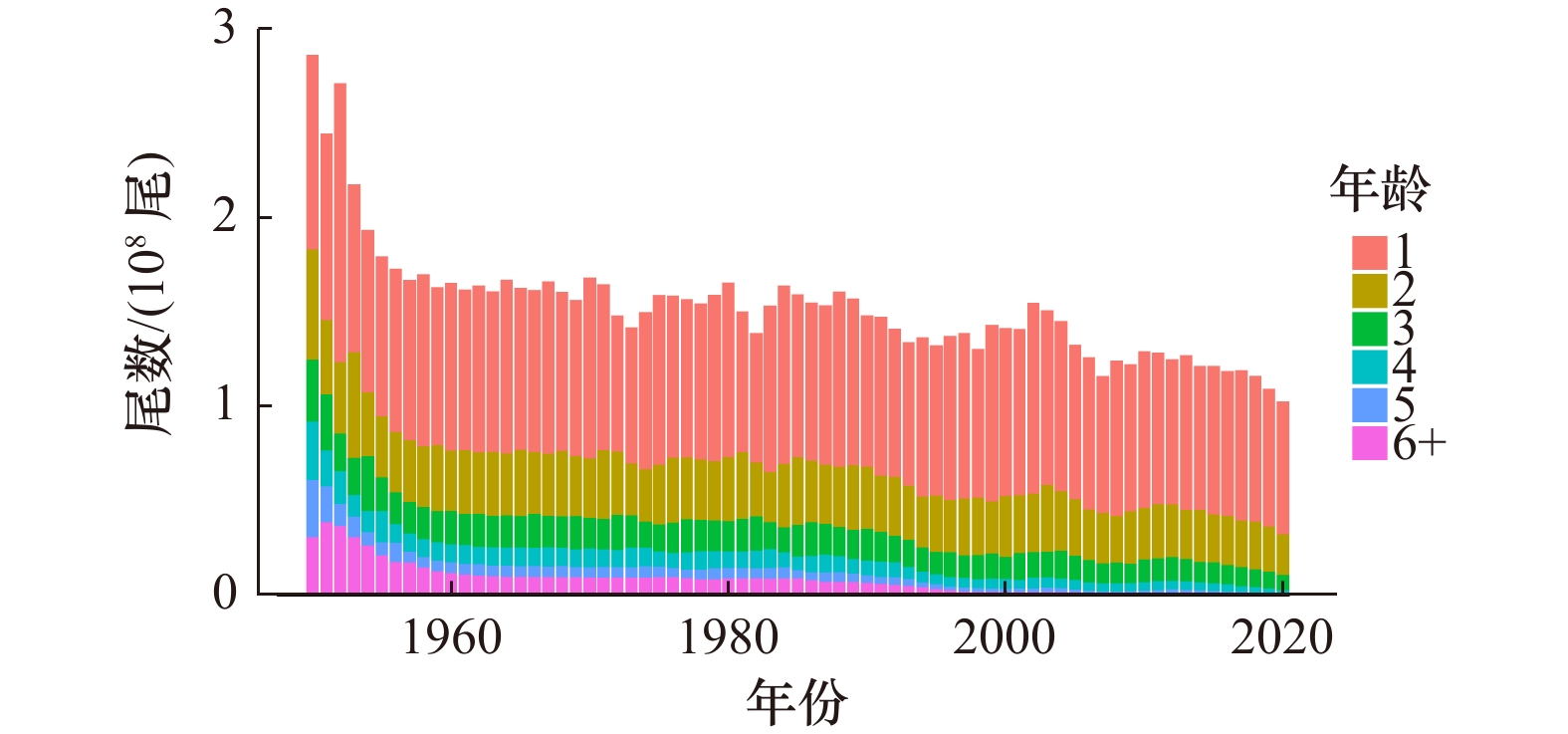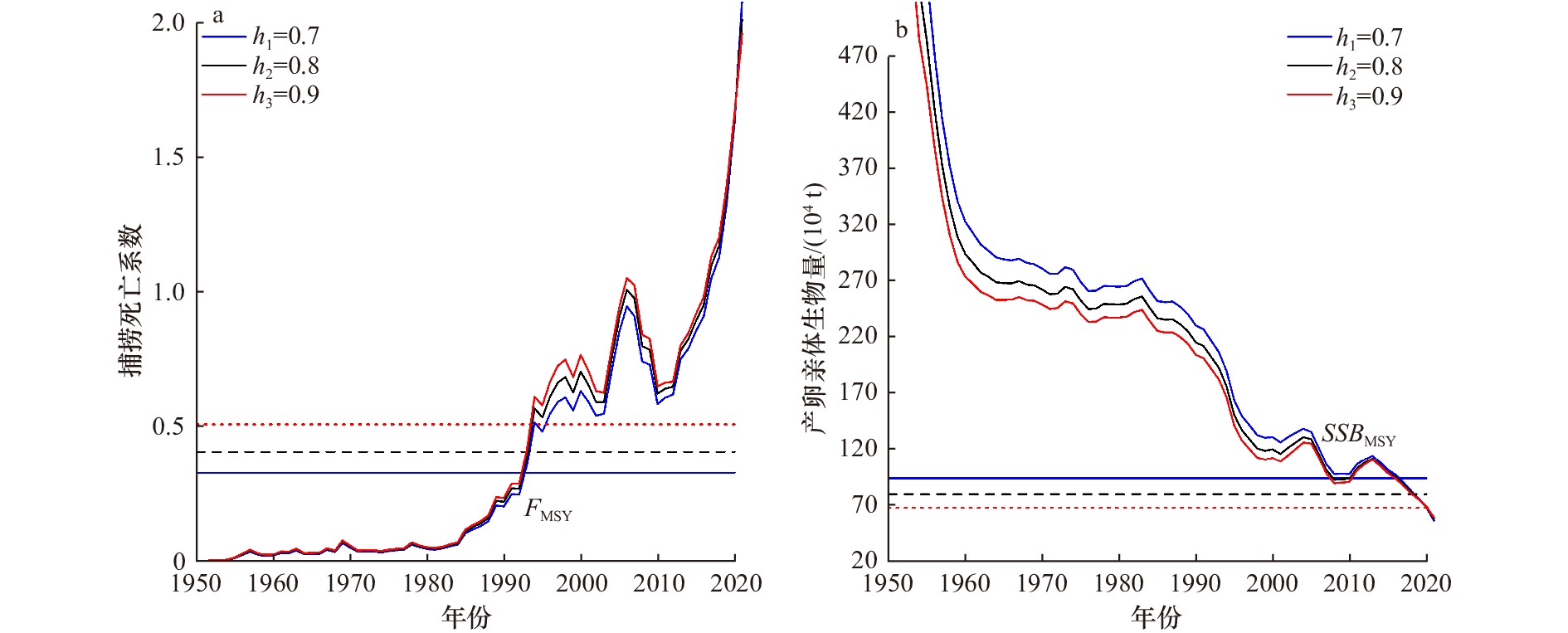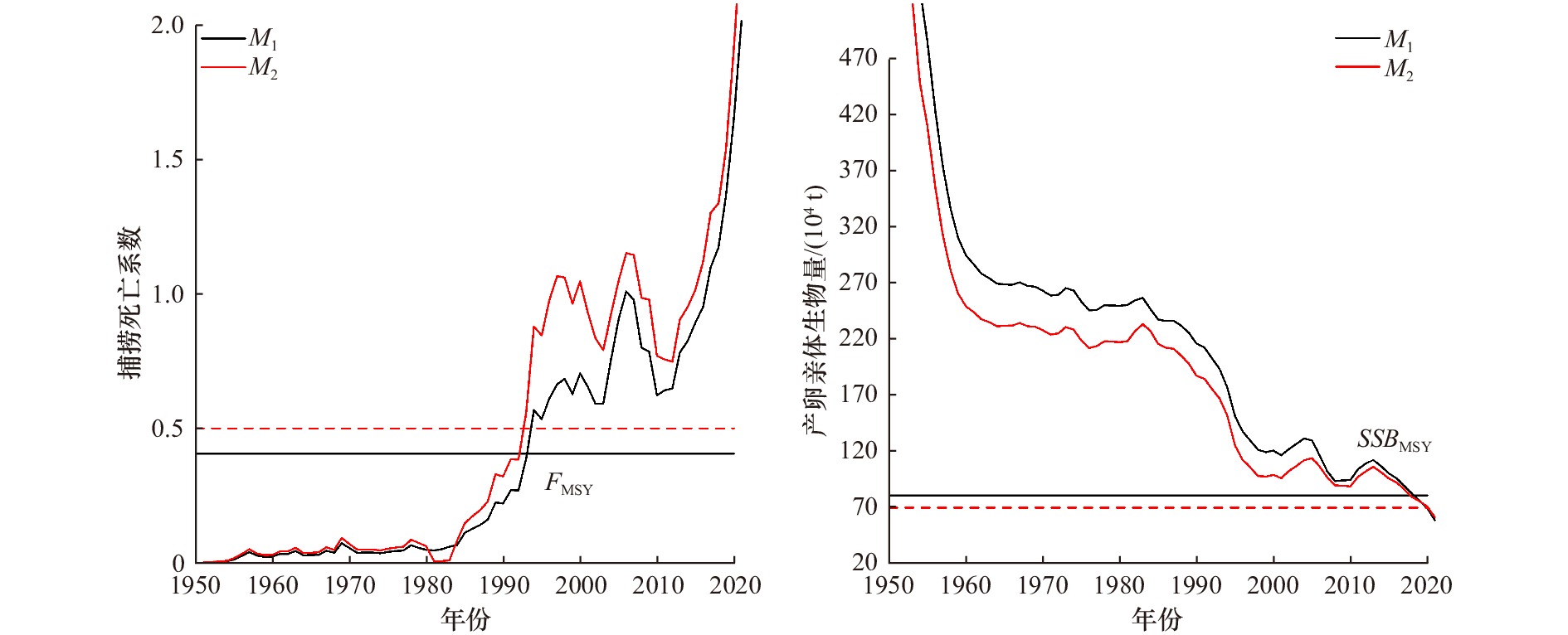Influence of natural mortality and stock-recruitment relationship on yellowfin tuna (Thunnus albacares) stock assessment
-
摘要: 黄鳍金枪鱼(Thunnus albacares)是全球经济和生态价值最重要的鱼类之一,其资源养护和管理受到各方的高度关注。本文依据年龄结构产量模型研究了印度洋黄鳍金枪鱼的资源状态,着重探讨了其生活史特征的不确定性对资源评估结果的影响。研究结果显示,1960−1985年间印度洋黄鳍金枪鱼资源量保持相对稳定,之后开始逐渐下降,相应的捕捞死亡系数也在2010年之后迅速增加,目前其种群可能存在过度捕捞(F2020/FMSY>1,SSB2020/SSBMSY<1)。印度洋黄鳍金枪鱼的资源评估结果对自然死亡系数(M)和亲体−补充量关系陡度参数(h)的改变较为敏感。当h增大时,SSBMSY和初始SSB(即SSB0)的变化较大,分别减少了约25.53万t和34.04万t;F2020/FMSY减小了1.15。当M增大时,F2020/FMSY、SSBMSY、SSB0均减小。综上所述,今后应重视印度洋黄鳍金枪鱼资源的开发程度,重视其资源养护管理,同时充分了解黄鳍金枪鱼的生活史特征,提高自然死亡系数和陡度参数估算的准确性,以期为印度洋黄鳍金枪鱼的资源评估和渔业管理提供更准确的信息,实现该渔业的长期可持续发展。Abstract: Yellowfin tuna (Thunnus albacares) is one of the most important fishes with great global economic and ecological value, and its conservation and management have received much concerns. The stock status of yellowfin tuna in the Indian Ocean based on the age-structured assessment program model is evaluated in this study, focusing on the uncertainties of its life history characteristics on the stock assessment results. The results show that the resources of yellowfin tuna in the Indian Ocean remained relatively stable from 1960 to 1985 and then declined gradually, while the fishing mortality coefficient F increased rapidly after 2010. This stock in 2020 may be overfished, since the estimated F2020 was greater than FMSY (F that could attain maximum sustainable yield MSY), while spawning stock biomass, SSB2020 was less than SSBMSY. Sensitivity analysis was also conducted to evaluate the uncertainties of stock assessment. Two important life history characteristics, natural mortality M and steepness of spawning-stock relationship h, were analyzed for their influence on the estimates of F, SSB and biological reference points. When h was set to 0.7, 0.8, and 0.9, SSBMSY and SSB0 (the unfished SSB) reduced by about 255 300 t and 340 400 t; and F2020/FMSY gradually decreased (from 2.88 to 2.21 and 1.73). When the M was set to M1 (0.963, 0.663, 0.548, 0.493, 0.463, 0.446) and M2 (1.068, 0.735, 0.608, 0.547, 0.514, 0.495) respectively, the larger M2 leads to lower SSB and F2020/FMSY. In summary, the conservation and management of Indian Ocean yellowfin tuna should be tightened in the future to achieve long-term sustainable development of this fishery. The life history characteristics of yellowfin tuna should be fully understood, especially M and h estimation should be improved, to provide more accurate information for stock assessment and fisheries management for Indian Ocean yellowfin tuna.
-
Key words:
- pelagic fishery /
- fish population dynamics /
- sensitivity analysis /
- natural mortality /
- steepness
-
表 1 各个模型的目标函数值及其主要组成
Tab. 1 The objective function of each model and its main components
模型 目标函
数值渔获量
成分丰度
指数渔获年龄
组成成分补充量
偏差S1 4 048 696 81 2998 273 S-base case 4 044 696 86 2993 269 S2 4 042 696 92 2988 266 S3 4 129 753 107 2994 275 表 2 各个模型的生物学参考点及相关参数
Tab. 2 Biological reference points and related parameters from each assessment model
生物参考点 模型 S1 S-base case S2 S3 F2020 0.98 0.93 0.90 0.96 SSB2020/t 558 920.7 575 049.9 589 316.9 602 132.8 SSB0/t 3 046 767 2 849 765 2 706 407 2 469 225 FMSY 0.34 0.42 0.52 0.52 F2020/FMSY 2.88 2.21 1.73 1.85 MSY/t 327 559 341 191 354 961 334 197 C2020/MSY 1.32 1.27 1.22 1.30 SSBMSY/t 991 582 854 369 736 282 745 318 SSB2020/SSBMSY 0.56 0.67 0.80 0.81 注:F2020为2020年捕捞死亡系数,SSB2020为2020年产卵亲体生物量,SSB0为未开发时的产卵亲体生物量,FMSY为最大可持续产量对应的捕捞死亡系数,MSY为最大可持续产量,SSBMSY为最大可持续产量对应的产卵亲体生物量,C2020为2020年渔获量。 表 3 印度洋黄鳍金枪鱼ASAP模型中的性成熟度、不同模型中设置的自然死亡系数和陡度参数
Tab. 3 Maturity, natural mortality and steepness parameter set in the ASAP model of yellowfin tuna in the Indian Ocean
年龄 S1 S-base case S2 S3 性成熟度[30] M1 h1 M1 h2 M1 h3 M2 h2 1 0.963 0.7 0.963 0.8 0.963 0.9 1.068 0.8 0 2 0.663 0.7 0.663 0.8 0.663 0.9 0.735 0.8 0.3 3 0.548 0.7 0.548 0.8 0.548 0.9 0.608 0.8 1 4 0.493 0.7 0.493 0.8 0.493 0.9 0.547 0.8 1 5 0.463 0.7 0.463 0.8 0.463 0.9 0.514 0.8 1 6+ 0.446 0.7 0.446 0.8 0.446 0.9 0.495 0.8 1 表 4 各个模型均方根误差
Tab. 4 Root mean square error for each model
模型 渔获量成分 丰度指数成分 补充量偏差成分 S1 0.62 1.37 1.58 S-base case 0.63 1.39 1.58 S2 0.63 1.41 1.57 S3 0.90 1.47 1.54 -
[1] 冯波, 陈新军, 西田勤. 应用年龄结构产量模型评估印度洋黄鳍金枪鱼资源[J]. 生态学报, 2010, 30(13): 3375−3384.Feng Bo, Chen Xinjun, Xi Tianqin. Stock assessment of Thunnus albacares in the Indian Ocean using age structured production mode[J]. Acta Ecologica Sinica, 2010, 30(13): 3375−3384. [2] Miyake M P, Guillotreau P, Sun C H, et al. Recent Developments in the Tuna Industry: Stocks, Fisheries, Management, Processing, Trade and Markets[M]. Rome, Italy: Food and Agriculture Organization of the United Nations, 2010. [3] 苗振清, 黄锡昌. 黄鳍金枪鱼资源利用状况分析[J]. 浙江海洋学院学报(自然科学版), 2003, 22(1): 7−11.Miao Zhenqing, Huang Xichang. Analysis on the status of resources utilization of yellowfin tuna Thunnus albacrares[J]. Journal of Zhejiang Ocean University (Natural Science), 2003, 22(1): 7−11. [4] 冯波, 陈新军, 许柳雄. 印度洋黄鳍金枪鱼渔业资源开发策略评价[J]. 农业系统科学与综合研究, 2009, 25(4): 506−510. doi: 10.3969/j.issn.1001-0068.2009.04.027Feng Bo, Chen Xinjun, Xu Liuxiong. Exploitation strategy evaluation for yollowfin tuna in the Indian Ocean[J]. System Sciences and Comprehensive Studies in Agriculture, 2009, 25(4): 506−510. doi: 10.3969/j.issn.1001-0068.2009.04.027 [5] 官文江, 吴佳文. 剩余产量模型形状参数对印度洋黄鳍金枪鱼资源评估的影响[J]. 上海海洋大学学报, 2019, 28(2): 298−304. doi: 10.12024/jsou.20180802389Guan Wenjiang, Wu Jiawen. Impacts of shape parameter of surplus production model on stock assessment of Indian Ocean yellowfin tuna[J]. Journal of Shanghai Ocean University, 2019, 28(2): 298−304. doi: 10.12024/jsou.20180802389 [6] Langley A. Stock assessment of yellowfin tuna in the Indian Ocean using Stock Synthesis[R] Montpellier: IOIC, 2015. [7] Legault C M, Restrepo V R. A flexible forward age-structured assessment program[R]. Genoa: ICCAT’s Collective Volume of Scientific Papers 492, 1998: 246−253. [8] Cass-Calay S L, Diaz G A, Nowlis J S. Revised assessments of Gulf of Mexico red snapper during 1962−2003 using a Gulfwide implementation of an age-structured-assessment-program (ASAP)[R]. Miami, FL USA: NOAA Fisheries, Southeast Fisheries Science Center, 2005. [9] 官文江, 朱江峰, 高峰. 印度洋长鳍金枪鱼资源评估的影响因素分析[J]. 中国水产科学, 2018, 25(5): 1102−1114. doi: 10.3724/SP.J.1118.2018.17303Guan Wenjiang, Zhu Jiangfeng, Gao Feng. Analysis of influencing factors on stock assessment of the Indian Ocean albacore tuna (Thunnus alalunga)[J]. Journal of Fishery Sciences of China, 2018, 25(5): 1102−1114. doi: 10.3724/SP.J.1118.2018.17303 [10] 官文江, 田思泉, 朱江峰, 等. 渔业资源评估模型的研究现状与展望[J]. 中国水产科学, 2013, 20(5): 1112−1120. doi: 10.3724/SP.J.1118.2013.01112Guan Wenjiang, Tian Siquan, Zhu Jiangfeng, et al. A review of fisheries stock assessment models[J]. Journal of Fishery Sciences of China, 2013, 20(5): 1112−1120. doi: 10.3724/SP.J.1118.2013.01112 [11] 詹秉义. 渔业资源评估[M]. 北京: 中国农业出版社, 1995.Zhan Bingyi. Fishery Stock Assessment[M]. Beijing: China Agricultural Press, 1995. [12] Hamel O S. A method for calculating a meta-analytical prior for the natural mortality rate using multiple life history correlates[J]. ICES Journal of Marine Science, 2015, 72(1): 62−69. [13] Zheng J. Uncertainties of natural mortality estimates for eastern Bering Sea snow crab, Chionoecetes opilio[J]. Fisheries Research, 2003, 65(1/3): 411−425. [14] Vetter E F. Estimation of natural mortality in fish stocks: a review[J]. Fishery Bulletin, 1988, 86(1): 25−43. [15] 王艳君. 渔业种群亲体与补充量关系研究[D]. 青岛: 中国海洋大学, 2006.Wang Yanjun. Relationships of stock and recruitment in fish stock assessment[D]. Qingdao: Ocean University of China, 2006. [16] 官文江, 唐琳, 田思泉, 等. 利用生物量动态模型与Euler-Lotka方程估算亲体−补充量模型的陡度参数[J]. 中国海洋大学学报(自然科学版), 2016, 46(10): 48−56.Guan Wenjiang, Tang Lin, Tian Siquan, et al. Using biomass dynamic model and Euler-Lotka equation to estimate steepness of stock-recruitment relationship[J]. Periodical of Ocean University of China, 2016, 46(10): 48−56. [17] 朱江峰, 戴小杰, 官文江. 印度洋长鳍金枪鱼资源评估[J]. 渔业科学进展, 2014, 35(1): 1−8. doi: 10.3969/j.issn.1000-7075.2014.01.001Zhu Jiangfeng, Dai Xiaojie, Guan Wenjiang. Stock assessment of albacore Thunnus alalunga in the Indian Ocean[J]. Progress in Fishery Sciences, 2014, 35(1): 1−8. doi: 10.3969/j.issn.1000-7075.2014.01.001 [18] Zhu Jiangfeng, Guan Wenjiang, Xu Liuxiong. Stock assessment of Indian Ocean albacore (Thunnus alalunga) using age structured assessment program (ASAP) [R]. Busan: IOTC, 2014. [19] Lee H H, Maunder M N, Piner K R, et al. Estimating natural mortality within a fisheries stock assessment model: an evaluation using simulation analysis based on twelve stock assessments[J]. Fisheries Research, 2011, 109(1): 89−94. doi: 10.1016/j.fishres.2011.01.021 [20] Tian Zhipan, Wang Fei, Tian Siquan, et al. Stock assessment for Atlantic yellowfin tuna based on extended surplus production model considering life history[J]. Acta Oceanologica Sinica, 2022, 41(8): 41−51. doi: 10.1007/s13131-021-1924-x [21] Carruthers T, Kell L, Palma C. Accounting for uncertainty due to data processing in virtual population analysis using Bayesian multiple imputation[J]. Canadian Journal of Fisheries and Aquatic Sciences, 2018, 75(6): 883−896. doi: 10.1139/cjfas-2017-0165 [22] 陶玉蕾. 敏感性分析在远洋渔业经济效益核算中的应用[J]. 广东农业科学, 2010, 37(7): 151−152. doi: 10.3969/j.issn.1004-874X.2010.07.068Tao Yulei. The application of sensitivity analysis on economic benefits accounting of deep-sea fishery[J]. Guangdong Agricultural Sciences, 2010, 37(7): 151−152. doi: 10.3969/j.issn.1004-874X.2010.07.068 [23] IOTC Working Party Tropical Tunas-23. IOTC-2021-WPTT23(AS)-DATA11[EB/OL]. [2021−11−07]. https://www.iotc.org/meetings/23rd-working-party-tropical-tuna-wptt23. [24] IOTC Working Party Tropical Tunas-23. IOTC-2021-WPTT23(AS)-DATA15-CPUE[EB/OL]. [2021−11−07]. https://www.iotc.org/meetings/23rd-working-party-tropical-tuna-wptt23. [25] NOAA Fisheries Toolbox. Technical documentation for ASAP version 3.0[EB/OL]. [2021−11−07]. https://nmfs-fish-tools.github.io/ASAP/. [26] 李亚楠, 戴小杰, 朱江峰, 等. 渔获量不确定性对印度洋大眼金枪鱼资源评估的影响[J]. 渔业科学进展, 2018, 39(5): 1−9. doi: 10.19663/j.issn2095-9869.20170627001Li Ya’nan, Dai Xiaojie, Zhu Jiangfeng, et al. Impact of catch uncertainty on the stock assessment of bigeye tuna (Thunnus obesus) in the Indian Ocean[J]. Progress in Fishery Sciences, 2018, 39(5): 1−9. doi: 10.19663/j.issn2095-9869.20170627001 [27] 童玉和, 陈新军, 田思泉, 等. 渔业管理中生物学参考点的理论及其应用[J]. 水产学报, 2010, 34(7): 1040−1050.Tong Yuhe, Chen Xinjun, Tian Siquan, et al. Theory and application of biological reference points in fisheries management[J]. Journal of Fisheries of China, 2010, 34(7): 1040−1050. [28] Von Bertalanffy L. A quantitative theory of organic growth (inquiries on growth laws. II)[J]. Human Biology, 1938, 10(2): 181−213. [29] Rohit P, Syda R G, Rammohan K. Age, growth and population structure of the yellowfin tuna Thunnus albacares (Bonnaterre, 1788) exploited along the east coast of India[J]. Indian Journal of Fisheries, 2012, 59(1): 1−6. [30] Zudaire I, Murua H, Grande M, et al. Reproductive potential of yellowfin tuna (Thunnus albacares) in the western Indian Ocean[J]. Fishery Bulletin, 2013, 111(3): 252−264. doi: 10.7755/FB.111.3.4 [31] Hoyle S D. Approaches for estimating natural mortality in tuna stock assessments: application to Indian Ocean yellowfin tuna[EB/OL]. [2021−12−07]. https://www.iotc.org/meetings/23rd-workingparty-tropical-tuna-wptt23. [32] Then A Y, Hoenig J M, Hall N G, et al. Evaluating the predictive performance of empirical estimators of natural mortality rate using information on over 200 fish species[J]. ICES Journal of Marine Science, 2015, 72(1): 82−92. doi: 10.1093/icesjms/fsu136 [33] Cardinale M, Fu D, Methot R, et al. Preliminary Indian Ocean yellowfin tuna stock assessment 1950−2020 (Stock Synthesis)[EB/OL]. [2021−12−07]. https://www.iotc.org/meetings/23rd-workingparty-tropical-tuna-wptt23. [34] 朱江峰. 运用SS3评估东太平洋大眼金枪鱼(Thunnus obesus)资源——复杂模型和简化模型的比较[J]. 渔业科学进展, 2017, 38(3): 12−21. doi: 10.11758/yykxjz.20160210001Zhu Jiangfeng. Stock assessment of big-eye tuna Thunnus obesus in eastern Pacific Ocean: a comparative study of the full and the simplified SS3 model[J]. Progress in Fishery Sciences, 2017, 38(3): 12−21. doi: 10.11758/yykxjz.20160210001 [35] Zhu Jiangfeng, Chen Yong, Dai Xiaojie, et al. Implications of uncertainty in the spawner-recruitment relationship for fisheries management: an illustration using bigeye tuna (Thunnus obesus) in the eastern Pacific Ocean[J]. Fisheries Research, 2012, 119−120: 89−93. doi: 10.1016/j.fishres.2011.12.008 [36] Harley S J. Preliminary examination of steepness in tunas based on stock assessment results [SA IP 08][R]. Pohnpei: Western and Central Pacific Fisheries Commission (WCPFC), 2011. [37] Shepherd G, Cieri M, Power M, et al. Transboundary resources assessment committee gulf of maine/georges bank Atlantic herring stock assessment update[R]. Ottawa, Ontario: Fisheries and Oceans Canada, 2009. [38] Dichmont C M, Deng R A, Punt A E, et al. A review of stock assessment packages in the United States[J]. Fisheries Research, 2016, 183: 447−460. doi: 10.1016/j.fishres.2016.07.001 [39] Crone P R, Conser R J, McDaniel J D. Population analysis of north Pacific Albacore based on an Age-structured assessment program (ASAP) model[J]. Collective Volume of Scientific Papers of the ICCAT, 2006, 59(3): 890−907. [40] 田志盼, 田思泉, 戴黎斌, 等. 基于贝叶斯状态空间产量模型的大西洋黄鳍金枪鱼资源评估[J]. 海洋学报, 2021, 43(2): 67−77.Tian Zhipan, Tian Siquan, Dai Libin, et al. Stock assessment for Atlantic yellowfin tuna based on Bayesian state-space production model[J]. Haiyang Xuebao, 2021, 43(2): 67−77. [41] Sant’Ana R, Mourato B, Kimoto A, et al. Atlantic yellowfin tuna stock assessment: an implementation of Bayesian state-space surplus production model using JABBA[J]. JABBA: Just Another Bayesian Biomass Assessment, 2020, 76(6): 699−724. [42] Davies N, Harley S, Hampton J, et al. Stock assessment of yellowfin tuna in the western and central Pacific Ocean[R]. Majuro: WCPFC Scientific Committee, 2014. [43] Minte-Vera C, Maunder M N, Xu Haikun, et al. Yellowfin tuna in the eastern Pacific Ocean, 2019: benchmark assessment[R]. San Diego: 11th Meeting Scientific Advisory Committee, 2020. [44] 官文江, 朱江峰, 田思泉. 应用贝叶斯生物量动态模型评估印度洋黄鳍金枪鱼资源[J]. 中国水产科学, 2018, 25(3): 621−631. doi: 10.3724/SP.J.1118.2018.17280Guan Wenjiang, Zhu Jiangfeng, Tian Siquan. Assessment of the Indian Ocean yellowfin tuna (Thunnus albacares) using a Bayesian biomass dynamic model[J]. Journal of Fishery Sciences of China, 2018, 25(3): 621−631. doi: 10.3724/SP.J.1118.2018.17280 [45] Nishida T. Preliminary stock assessment of yellowfin tuna (Thunnus Albacares) in the Indian Ocean by the ADMB based ASPM[R]. Bangkok: IOTC, 2008. [46] 张中帅. 印度洋金枪鱼资源开发与管理现状分析[D]. 上海: 上海海洋大学, 2017.Zhang Zhongshuai. Analysis of status with utilization and management of the tuna resources in the Indian Ocean[D]. Shanghai: Shanghai Ocean University, 2017. [47] Pecoraro C, Zudaire I, Bodin N, et al. Putting all the pieces together: integrating current knowledge of the biology, ecology, fisheries status, stock structure and management of yellowfin tuna (Thunnus albacares)[J]. Reviews in Fish Biology and Fisheries, 2017, 27(4): 811−841. doi: 10.1007/s11160-016-9460-z [48] Indian Ocean Tuna Commission. Compendium of active conservation and management measures for the Indian Ocean tuna commission[R]. Victoria: IOTC, 2022. [49] 官文江. R语言在海洋渔业中的应用[M]. 北京: 海洋出版社, 2015.Guan Wenjiang. Application of R Language in Marine Fishery[M]. Beijing: China Ocean Press, 2015. [50] 崔明远, 田思泉, 麻秋云, 等. 基于单位补充量模型的浙江南部海域蓝圆鲹资源评价[J]. 水产科学, 2022, 41(5): 727−737.Cui Mingyuan, Tian Siquan, Ma Qiuyun, et al. Assessment for Japanese scad Decapterus maruadsi fishery in offshore waters of Southern Zhejiang based on per recruitment model[J]. Fisheries Science, 2022, 41(5): 727−737. [51] Francis R I C C. Use of risk analysis to assess fishery management strategies: a case study using orange roughy (Hoplostethus atlanticus) on the Chatham Rise, New Zealand[J]. Canadian Journal of Fisheries and Aquatic Sciences, 1992, 49(5): 922−930. doi: 10.1139/f92-102 [52] Sparre P, Venema S C. Introduction to Tropical Fish Stock Assessment. Part 2: Exercises[M]. Rome: Food and Agriculture Organization of the United Nations, 1999. [53] Sippel T, Lee H H, Piner K, et al. Searching for M: is there more information about natural mortality in stock assessments than we realize?[J]. Fisheries Research, 2017, 192: 135−140. doi: 10.1016/j.fishres.2016.12.009 [54] Indian Ocean Tuna Commission. Resolution 21/01 on an interim plan for rebuilding the Indian Ocean yellowfin tuna stock in the IOTC area of competence[R]. Victoria: IOTC, 2021. [55] Indian Ocean Tuna Commission. Resolution 19/01 on an interim plan for rebuilding the Indian Ocean yellowfin tuna stock in the IOTC area of competence[R]. Victoria: IOTC, 2019. [56] Indian Ocean Tuna Commission. Resolution 18/01 on an interim plan for rebuilding the Indian Ocean yellowfin tuna stock in the IOTC area of competence[R]. Victoria: IOTC, 2018. [57] Indian Ocean Tuna Commission. Resolution 17/01 on an interim plan for rebuilding the Indian Ocean yellowfin Tuna stock in the IOTC area of competence[R]. Victoria: IOTC, 2017. [58] Indian Ocean Tuna Commission. Resolution 16/01 on an interim plan for rebuilding the Indian Ocean yellowfin tuna stock in the IOTC area of competence[R]. Victoria: IOTC, 2016. -




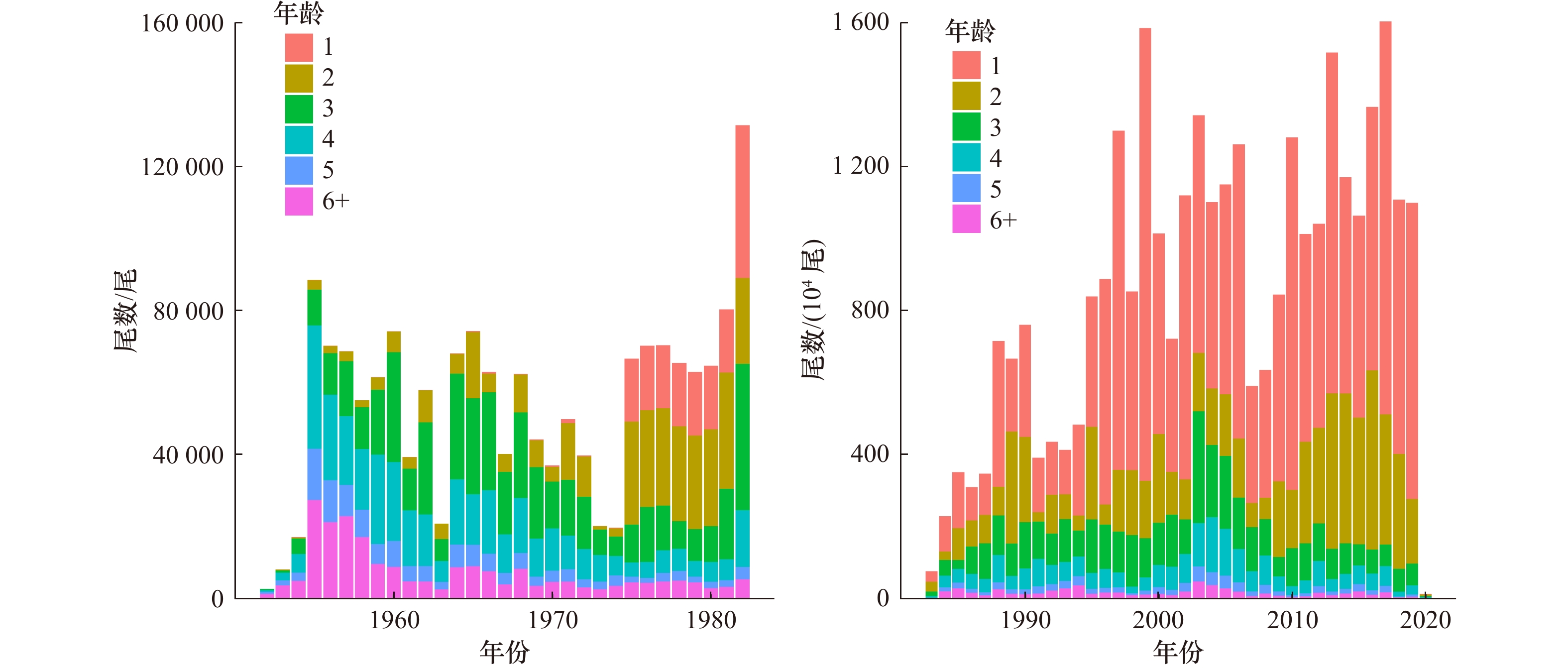
 下载:
下载:

